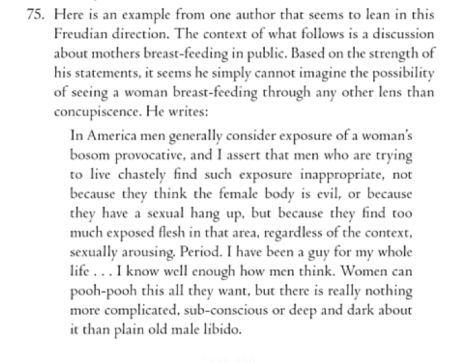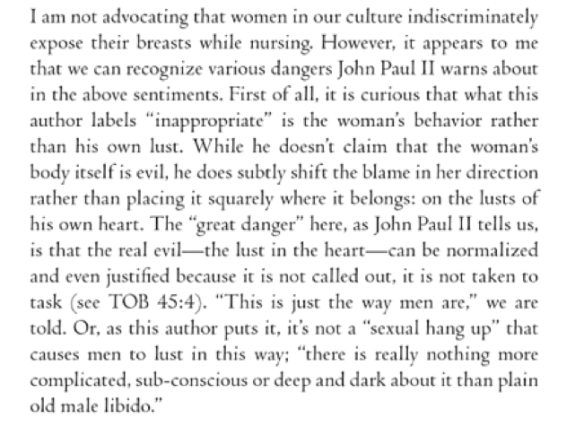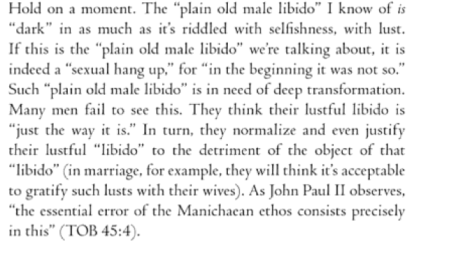
Absorbed in my thoughts on the occult/Harry Potter book, I have not even thought about posting here recently. I did take a break a month ago to write an article for Inside the Vatican on the Theology of the Body. It was published in the June-July issue under the title “The Pagan Temptation” (39-41). I am grateful for the opportunity.
Here is a short excerpt that touches upon a topic which will be addressed at length in my book:
If the imagination is the place where illustrative analogies must be devised for the sake of apologetics and evangelization, and if it is also the place where the mythological and magical way of thinking reorganizes images for the purposes of mystical experience and psychic control over nature, then we should be careful not to confuse these two functions. Avoiding such confusion might prove to be particularly difficult if the matter at hand involves erotic images, because the imagination is also the place where we are particularly vulnerable to the demonic.
I will not be writing much about the issue of chastity in the book. However, the imagination and its role in both evangelization and its abuse through the occult will be a major theme.
Please pray that I can successfully bring this book to a conclusion. Thanks.
I will leave you with another article I wrote recently for our international magazine.
Our Lady’s Presence in Blessed John Paul II
I too wish to begin my reflection on the role of Mary in the mystery of Christ and on her active and exemplary presence in the life of the Church.
–Blessed Pope John Paul II, Redemptoris Mater
In this way the new blessed of the Church, Pope John Paul II, describes the subject of his great Marian Encyclical in its opening section. Mary, he writes, has a role “in the mystery of Christ,” and She has a presence within the Church that is “active and exemplary.” In stating this, he is echoing St. Paul in the Letter to the Galatians where the Apostle writes of the fullness of time in which God sent for the his Son, born of a woman, so that we might receive the adoption of sons (4:4-6). In his own Life Blessed Pope John Paul II showed that what he wrote about the Blessed Mother’s presence in the Church he also experienced personally.
Marian Mediation and Presence
In Catholic tradition this relationship of Mary with the Church has been called Her universal mediation of graces, though today in many Catholic circles the use of this language had come to be considered unfashionable and “unecumenical.” In reality, the terminology is entirely consistent with scripture, because God did send His son through the mediation of a woman, as St. Paul says. Jesus became a member of our family through Mary, so that we might become members of His family through Mary.
St. Paul’s statement puts Mary between God and our adoptive sonship. That is what we mean by Marian mediation. In fact, in the encyclical letter, Blessed John Paul II expressly states: “She puts herself ‘in the middle,’ that is to say she acts as a mediatrix not as an outsider, but in her position as mother” (21).
The great pope of this Marian age, not only made it fashionable to speak about Marian mediation again, he gave our understanding of this role of Our Lady his characteristic personalist touch. He calls it Her “active and exemplary presence in the life of the Church.” Just as he says “she puts herself ‘in the middle’ . . . in her position as mother,” so he indicates that this middle position is a kind of “active and exemplary presence.” Our Mother is with us and She acts from within and with power.
Mary’s mediation of graces is described by some theologians as functioning in a physical way, which is simply to say that it produces its effect by means of a kind of power. Blessed Pope John Paul does not contradict this, but rather emphasizes that this power does not simply pass through Our Lady as though She was a conduit of spiritual energy, as it were, but her mediation is a function of Her spiritual motherhood by which She deeply and personally helps to constitute, maintain and augment a filial relationship between us and God, our Father. Grace is the life of God and Mary is mother in the order of grace. She is present in our lives in an “active and exemplary” way.
Active Presence
Mary’s active presence in the Church means precisely that She is more than a channel. In the encyclical, Blessed John Paul really makes this very clear by using words in Latin to express the fact that Mary’s presence is deep and dynamic. For example, “active” presence is designated by the word actuosa rather than activa, which indicates that the presence is not a matter so much of physical action, but of “a really deep, personal” kind of communion. Incidentally, when today when the Church encourages “active participation” in the liturgy, the word used is actuosa (Ratzinger Report, 127), indicating that we should enter deeply and consciously into the mystery of the liturgical rite. Mary enters deeply and personally into the lives of Her children.
Elsewhere in the encyclical, when Blessed John Paul writes about Our Lady’s presence he uses words that indicate a dynamic presence. For instance, seven times he uses a form of the phrase praesens adest (translated “is present”) in which the adest bears the nuance of “to be toward by way of action.” He writes that Mary, “in a discreet yet direct and effective way” made the mystery of Christ present to humanity. This direct and efficacious mediation of Christ’s presence by Mary, the Holy Father tells us, continues to this day. “Through the mystery of Christ, she too is present within mankind” (19). He also writes that Mary is present “in the history of souls,” that is, through the interior pilgrimage of faith, which is both personal and immediate (25).
Exemplary Presence
Mary’s exemplary presence in the Church means that Mary is both the model and mother of the Church. Blessed John Paul writes (again, using the verb praesens adhest) that Mary is a “permanent model” (perenne exemplar) or “figure” (typus) of the Church and that She, “present in the mystery of Christ, remains constantly present also in the mystery of the Church” (42). Later on he says that to call Mary model and figure of the Church is not sufficient but instead relates Her role of model to Her motherhood of the Church (47). And in a general audience of August 6, 1997, he clarified that by calling Mary type of the Church he was not referring to Her as an “imperfect prefiguration,” but as an “example of perfection to be followed and imitated” (3,4). In other words, Mary is present to each of us as a living example who acts personally and deep within in us as a true mother.
We can say, then that the active and exemplary presence of Our Lady in the mystery of the Church, is a real, deep, immediate, personal and active involvement of Our Lady in the life of Our soul, where She imprints Her own thoughts, dispositions and virtues as Model and Mother and Mediatrix.
The Presence of Blessed John Paul II
In his homily for the beatification of John Paul II, Pope Benedict XVI commented on the “theological vision” of the new blessed which he discovered as a young man and nurtured throughout his life. Blessed John Paul contemplated Our Lady’s presence at the foot of the Cross next to Jesus. This is what he meant to signify when he chose for his papal coat-of-arms, an “M” to the lower right of a cross, with the inscription, Totus Tuus, taken from the words of St. Louis Grignon de Montort, meaning “I belong entirely to you.” In the homily Pope Benedict said:
Mary does not appear in the accounts of Christ’s resurrection, yet hers is, as it were, a continual, hidden presence: she is the Mother to whom Jesus entrusted each of his disciples and the entire community. In particular we can see how Saint John and Saint Luke record the powerful, maternal presence of Mary in the passages preceding those read in today’s Gospel and first reading. In the account of Jesus’ death, Mary appears at the foot of the cross (Jn 19:25), and at the beginning of the Acts of the Apostles she is seen in the midst of the disciples gathered in prayer in the Upper Room (Acts 1:14) [emphasize mine].
In this great new hero of the Church, we are blessed with his celestial presence, as we miss his earthly one, and we pray that we might have his vision of Our Lady, so that we might truly know how deeply and actively She is present within the Church and within our own souls. This great Marian pope, has taught us the full truth about Mary and has lived that teaching in an extraordinary way. He acknowledged Her presence in his own mission and especially in his extraordinary suffering, and he invoked her presence on the Church and on each individual soul. May our own deep and personal participation in the presence of Mary lead us along the same path is this great Marian apostle. Blessed Pope John Paul II, pray for us.

 Christopher West has quoted me in his new book, At the Heart of the Gospel: Reclaiming the Body for the New Evangelization.
Christopher West has quoted me in his new book, At the Heart of the Gospel: Reclaiming the Body for the New Evangelization.


 After all West speaks about the language of the body precisely in terms of sexual values. Those values, sexual desire, sexual pleasure and the conjugal act itself point beyond themselves to desire for unity with God, the bliss of heaven and the mutual self-giving of God and the soul. So when West suggests that we should have a holy fascination with the body and sex, as he does, for example in
After all West speaks about the language of the body precisely in terms of sexual values. Those values, sexual desire, sexual pleasure and the conjugal act itself point beyond themselves to desire for unity with God, the bliss of heaven and the mutual self-giving of God and the soul. So when West suggests that we should have a holy fascination with the body and sex, as he does, for example in 
